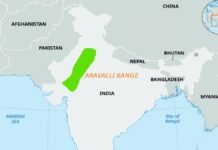
Key Points
- ₹28 crore overbridge near Railway Gate No. 104 in Sehore features controversial 90-degree turn
- Bridge spans 700 meters in length and 15 meters in width with 24 pillars constructed
- Height clearance from railway tracks set at 7.30 meters
- Drone images exposed the sharp angular design, sparking public backlash
- No approach roads constructed on either side despite location in busy area with heavy traffic
- Bridge terminates on privately-owned land, allegedly forcing the curved design
- Sehore SDM Tanmay Verma has ordered investigation by Bridge Corporation EE A.R. More
- Controversy follows Bhopal’s Aishbagh overbridge scandal where seven PWD engineers were suspended in June 2025
Sehore: The railway overbridge being constructed near Railway Gate No. 104 on the old Indore-Bhopal State Highway in Sehore city has become the center of a major controversy after drone images revealed what appears to be a precarious 90-degree turn in its structure. The aerial footage, which circulated widely on social media, immediately drew comparisons to Bhopal’s notorious Aishbagh overbridge that became a subject of national ridicule and sparked administrative action earlier this year.
Local residents expressed shock and outrage upon seeing the images, claiming that the bridge had been arbitrarily designed with the wrong directional alignment. Citizens allege that construction work began without proper topographical surveys or adequate planning, forcing engineers to awkwardly reroute the bridge mid-construction to accommodate unforeseen obstacles. The resulting structure features an unusual angular curve that many fear could become a death trap for motorists, particularly two-wheelers and heavy vehicles attempting to navigate the sharp turn.
The controversy has raised serious questions about project planning, site surveys, and quality control mechanisms in Madhya Pradesh’s public works projects, especially given that this is occurring in Chief Minister Mohan Yadav’s home district of Sehore.
Technical Specifications and Construction Details
The overbridge project, which carries an estimated cost of ₹28 crore, is being constructed to alleviate traffic congestion caused by the railway level crossing at Gate No. 104. The structure spans approximately 700 meters in length and 15 meters in width, designed to accommodate multiple lanes of vehicular traffic. A total of 24 concrete pillars are being erected to support the elevated roadway, with the bridge deck positioned at approximately 7.30 meters above the railway tracks below to ensure adequate clearance for train operations.
Despite the substantial investment and scale of the project, fundamental design flaws have become apparent as construction progresses. According to engineering experts who have examined the drone footage, the bridge exhibits several technical deficiencies that compromise both safety and functionality. The most glaring issue is the sharp angular turn that forces vehicles to slow dramatically and navigate a hazardous curve on an elevated structure where escape options are limited.
Local residents point out that officials from the construction agency and the Public Works Department began work without conducting comprehensive surveys of the terrain, land ownership patterns, and traffic flow requirements. This lack of due diligence allegedly led to a situation where engineers discovered mid-construction that the bridge’s planned endpoint conflicted with property boundaries, necessitating the controversial directional change.
Missing Approach Roads Compound Safety Concerns
Adding to the infrastructure deficiencies, approach roads have not been constructed on either side of the overbridge, despite its location in one of Sehore’s busiest urban areas. The site witnesses the daily passage of thousands of vehicles, including school buses, commercial trucks, two-wheelers, and private cars. Hundreds of schoolchildren cross this intersection daily on their way to educational institutions, making the absence of proper approach infrastructure particularly alarming.
Without properly graded approach roads featuring gentle inclines and adequate turning radii, vehicles will be forced to navigate dangerous, improvised pathways to access the elevated bridge deck. This situation is especially hazardous for heavy commercial vehicles, which require substantial space and gradual slopes to safely ascend to elevated roadways. Two-wheelers and pedestrians face equally serious risks as they attempt to use makeshift access points lacking safety barriers, proper lighting, or marked pathways.
Local residents emphasize that their opposition is not directed at development itself but rather at the fundamentally flawed design and execution of the project. Community leaders have warned that if significant improvements are not made before the bridge becomes operational, they will file complaints with the Lokayukta (ombudsman), State Human Rights Commission, and Madhya Pradesh High Court, seeking intervention to protect public safety.
Land Ownership Issues Force Design Compromise
According to civil engineering experts who have analyzed the project, the bridge’s problematic design stems largely from land acquisition failures. The area where the bridge is supposed to terminate remains under private ownership, with authorities apparently failing to secure the necessary land rights before commencing construction. Faced with this predicament mid-project, the construction agency was forced to curve the bridge at an acute angle to avoid encroaching on private property.
This compromise solution has resulted in what critics describe as a “swaying overbridge”—a structure that bends at an unnatural angle rather than following a straight, safe alignment. Furthermore, a service road was constructed on only one side of the bridge, creating an imbalanced approach system that will funnel all traffic through a single access point, inevitably creating bottlenecks and increasing accident risks.
The situation highlights serious deficiencies in project planning and inter-departmental coordination. Proper procedure requires that all land acquisition, Railway Board approvals, and General Arrangement Drawings (GAD) be finalized before construction commences. The apparent failure to follow these protocols has transformed what should have been a symbol of infrastructural progress into an embarrassing example of administrative negligence.
Administration Orders Investigation
As public protests intensified, Sehore Sub-Divisional Magistrate (SDM) Tanmay Verma intervened by ordering a formal investigation into the bridge design and construction quality. The inquiry has been assigned to Bridge Corporation Executive Engineer A.R. More, who has been tasked with conducting a comprehensive technical assessment of the structure.
In his statement, SDM Verma emphasized that “public interest is paramount” and assured citizens that any errors or safety hazards identified during the investigation will be rectified before the bridge becomes operational. He stated that the administration takes the concerns of local residents seriously and is committed to ensuring that all infrastructure projects meet safety standards and serve community needs effectively.
However, many citizens remain skeptical about the investigation’s outcome. Given the advanced state of construction, they fear that the inquiry may become merely a formality, with officials ultimately declaring the bridge acceptable despite its obvious flaws. Residents point out that significant structural modifications would be costly and time-consuming, creating bureaucratic incentives to approve the existing design with only minor cosmetic changes.
Echoes of Bhopal’s Bridge Fiasco
The Sehore overbridge controversy has revived memories of the infamous Bhopal Aishbagh railway overbridge scandal that dominated headlines earlier in 2025. That structure, built near Aishbagh Stadium in the state capital, featured a sharp turn that was popularly described as “90 degrees,” though technical measurements later revealed it to be between 118-119 degrees.
The Bhopal bridge became a subject of widespread ridicule on social media, with memes comparing it to the mobile game “Temple Run” and questioning how vehicles could possibly negotiate such a sharp turn on an elevated structure. The controversy prompted Chief Minister Mohan Yadav to take decisive action in June 2025, suspending seven Public Works Department engineers and ordering a departmental probe against a retired superintendent engineer for the “faulty design”.
The state government also blacklisted the construction agency M/s Puneet Chadha and the design consultant involved in the Bhopal project. However, the company challenged this action in the Madhya Pradesh High Court, arguing that they had simply followed the General Arrangement Drawing (GAD) issued by government agencies and that the design was modified between 2023 and 2024 under official supervision.
An investigation committee found a lack of coordination between the state government and the Railways in the Bhopal bridge matter, noting that the rail track passes under the bend in the bridge and that pillars were not installed at prescribed distances. PWD officials explained that the sharp turn was necessitated by paucity of land and the presence of a nearby metro rail station, though they acknowledged that with additional land, the 90-degree turn could be converted into a smoother curve.
Pattern of Bridge Design Failures
The Sehore controversy is part of a troubling pattern of poorly designed overbridge projects in Madhya Pradesh. In July 2025, just weeks after the Bhopal scandal, another controversial structure emerged in Indore, a Z-shaped Railway Over Bridge near Polo Ground featuring two sharp 90-degree turns.
The Indore bridge sparked fresh safety concerns, with local industrialist associations opposing the construction and calling for urgent redesign. Congress leader Sajjan Singh Verma mockingly suggested that engineers were trying to outdo the Bhopal fiasco by introducing not one but two hazardous bends. PWD officials defended the design, claiming it met engineering standards with a 20-meter turning radius and a design speed of 20 kilometers per hour, while acknowledging that spatial constraints sometimes require such adjustments.
PWD Minister Rakesh Singh has consistently defended these controversial designs, stating that “wherever a bridge or a road has to be constructed over an old city, you don’t have space. Then you have to go the 90-degree way, many times such circumstances arise”. However, critics argue that this defense merely confirms inadequate planning and land acquisition processes, rather than justifying dangerous infrastructure.
Political Dimensions and Public Accountability
The Sehore overbridge controversy has taken on additional political significance, given that it is located in Chief Minister Mohan Yadav’s home district. Local Congress leaders have seized upon this fact, arguing that the flawed project reflects poorly on the state government’s commitment to quality infrastructure development even in the Chief Minister’s own constituency.
Opposition politicians and citizens alike have described the bridge as a “symbol of administrative negligence” rather than development. They question how such a fundamentally flawed design could receive approval and proceed to advanced construction stages in the Chief Minister’s home district, suggesting either gross incompetence or inadequate oversight mechanisms.
The controversy has sparked broader discussions about quality control in public infrastructure projects across Madhya Pradesh. Citizens are demanding transparent project reviews, stringent technical assessments before construction begins, and clear accountability for design failures. The repeated occurrence of similar problems—Bhopal, Indore, and now Sehore—suggests systemic issues in project planning and execution rather than isolated incidents.
Community Demands and Future Outlook
Local residents and civil society organizations in Sehore are demanding comprehensive corrections to the bridge design before it becomes operational. Specifically, they are calling for:
- Straightening or significantly widening the 90-degree bend to create a safer, more gradual curve
- Construction of proper approach roads on both sides with adequate gradients and turning radii
- Installation of appropriate safety barriers, lighting, signage, and traffic management systems
- Independent technical review by engineering experts from reputable institutions
- Public disclosure of the original design plans, modifications made during construction, and justifications for directional changes
Community leaders have made it clear that they will escalate their protests if these demands are not met. Legal action through the Lokayukta, Human Rights Commission, and High Court remains a viable option if administrative channels fail to produce satisfactory results.
Public attention is now focused on whether SDM Verma’s investigation will result in genuine corrective action or merely provide bureaucratic cover for an unchanged, dangerous design. The outcome of this case may set an important precedent for how Madhya Pradesh addresses infrastructure quality and safety concerns in future projects.
The Sehore overbridge, intended as a “bridge of development” to improve connectivity and ease traffic congestion, has instead become a focal point of controversy, public anger, and questions about governance. Whether it ultimately serves its intended purpose or becomes another cautionary tale of poor planning depends entirely on the willingness of authorities to prioritize public safety over bureaucratic convenience and construction expediency.



















































